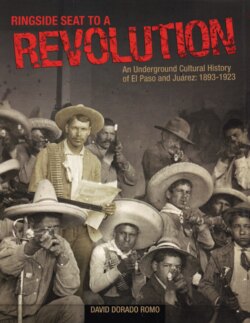Читать книгу Ringside Seat to a Revolution - David Dorado Romo - Страница 22
На сайте Литреса книга снята с продажи.
Оглавление17
SEVERAL EXCELLENT HISTORICAL works about the Mexican Revolution on the
border served as my guides during the writing of this book. Friedrich Katz’ The Life & Times
of Pancho Villa; Mario García’s Desert Immigrants; Oscar Martínez’ Fragments of the Mexican
Revolution;
Willivaldo Delgadillo and Maribel Limongi’s
La Mirada Desenterrada;
and
Miguel Angel Berumen and Pedro Siller’s 1911: La Batalla de Juárez, among others, provid-
ed very useful maps of the history and territory I’ve been exploring these past few years.
But the one historian who is perhaps the most responsible for getting me to write
about my own city is Leon Metz. I’ve run into him a few times at historical conferences.
The former law enforcement officer turned historian is an amiable man. He looks a little
like John Wayne and a little like Jeff Bridges. Everybody likes Leon Metz. He’s almost as
popular as the UTEP football coach. His books sell very well too. If you go to the histo-
ry section at any Barnes & Noble in El Paso, you
probably won’t find any of the books I’ve just
mentioned there. But you’re likely to find more
than a dozen books written by Leon Metz about
local gunfighters, sheriffs and Texas Rangers—
John Wesley Hardin, Pat Garrett, John Selman and
Dallas Stoudenmire. Occasionally Metz writes
about the Mexican Revolution too from that Wild,
Wild West cowboy perspective of his.
Let me give you an example. In Turning
Points in El Paso, Texas, the local historian is high-
ly critical of the revolutionary Spanish-language
newspapers that flourished in South El Paso
around the turn of the century. Metz—who does-
n’t read or speak Spanish—denounces many of
them as badly written “handbills” full of “emotion-
al, oftentimes hysterical overtones” whose content
“sounded impressive only to other social-anar-
chists.”2 He expresses displeasure with these publications that “frequently denounced the
United States (which protected their right to publish) as savagely as they did Díaz.”3 One
of those anarchistic newspapers he mentions is Regeneración, which Metz claims was
published out of the Caples Building in El Paso by Ricardo Flores Magón. (I’m not sure
how Magón—who established his headquarters in El Paso in 1906—could have published
his newspaper out of the Caples Building. The Caples wasn’t constructed until 1909.) The
Old West historian describes Magón as a friend of “bomb-throwers,” a man with “enough
real and imagined grievances to warrant psychotherapy for a dozen unhappy zealots.”4
Ay, ay, ay! Talk about bomb-throwers.
Them’s fightin’ words, as the Hollywood gunslingers of old used to say. They’re the
kind of outrageous distortions that would spur any self-respecting microhistorian worth
the name to reach for his laptop and write his own version of the past. Which I did.
Silvestre Terrazas (second on left)
and the staff of his newspaper
La Patria in El Paso Street, 1921.
Between 1890 and 1925, more than
40 Spanish-language newspapers
were published in El Paso.
(El Paso Public Library.)
1
Luz Corral de Villa, Pancho Villa en la intimidad, p. 59.
2
Leon Metz, Turning Points in El Paso, Texas, p. 90.
3
Ibid.
4
Metz, Turning Points, p. 88.
